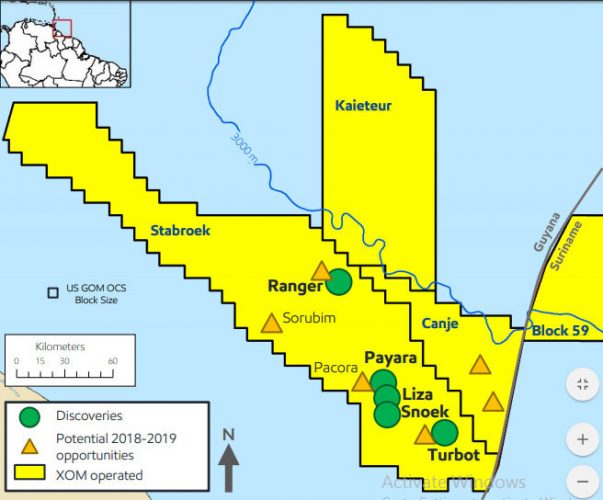
Vickram Bharrat
September 25 ,2020
ExxonMobil has secured approval for its Payara project in the Stabroek Block offshore Guyana and an agreement, which would also cater for stiff fines for flaring violations and a commitment that reservoir water be treated to international standards before dumping, should be signed soon, Minister of Natural Resources Vickram Bharrat has said.
“We are coming to the position where a production agreement is being drawn up and based on negotiations and consultations with the Attorney General’s Chambers,” Bharrat told Stabroek News when contacted, while noting that a “workable agreement” should be signed within days.
The Minister explained that details on applicable fines and new flaring provisions will be made public. “We will impose fines for flaring. Yes, we have an agreement to treat to international standards,” he added.
President Irfaan Ali had on Tuesday told this newspaper that his government’s immediate focus in the oil and gas sector included the review of ExxonMobil’s Payara project.
While the approval comes on the heels of a visit by United States Secretary of State Michael Pompeo, Bharrat recently dismissed concerns that the trip was tied to the project as he stressed that the US oil major must meet the necessary requirements and environmental standards before any approval would be granted.
Bharrat has said that teams from both government and ExxonMobil were meeting to settle issues relating to the project, including environmental matters such as flaring, water dumping and outstanding overlapping legal terms from the Liza-1 project.
He had also said that the teams were working around the clock to ensure that this country is satisfied that global environmental and safety standards are met before the licence is issued.
The PPP/C government announced last month that a review of the Payara Field Development Plan was initiated by the Department of Energy under the then APNU+AFC, which contracted Bayphase Oil and Gas Consultants at a sum of US$386,830 in December 27, 2019.
Through the Ministry of Natural Resources, it added that it had decided to review the work already undertaken by the Department of Energy, so that the interest of all Guyanese is protected and in keeping with international transparency and accountability standards prior to approval being given.
Bharrat said that it was because government did not want a permit granted based on a “minister or ministers’ discretion” that it turned to the Canadian government for help and thus Alison Redford, an international consultant and Canadian Queen’s Counsel, was hired.
It was the EPA’s Head Dr. Vincent Adams who had first raised concerns about the reservoir water dumping and had asked the company to show, through research, that there would be no impact on ocean and marine life.
Adams had also proposed a “tightening of the legal language” in the permit as it pertains to flaring so that periods of start-up flaring do not run into several months, while saying that it was unacceptable.
Exxon has to date flared over 10.2 billion cubic feet of natural gas and continues to flare at volumes of 12M to 15M cubic feet per day, and has not given a timeframe from when the problem would be resolved. When volumes went over 9 billion cubic feet, it was forced to reduce flaring volumes and in turn reduce oil production quotas to cushion the impact on the environment.
Adams has said that claims must be fact and research-based as he believes that it is vital to the future generations of this country and by extension the world that the environment must be protected.
But in the middle of the discussions and review of the Payara project, he was sent on leave by the new PPP/C government. This decision was strongly criticised and seen as a way to speed up the Payara approval. His leave will end on October 5th, possibly after the permit is signed and granted.
ExxonMobil has openly defended its plans to release thousands of gallons of reservoir water into the ocean instead of re-injecting it into wells, claiming that it could drive costs up and this country would need to determine the balance it takes.
“The water that we produce is treated on the vessel and what is discharged causes no damage to the environment. It is treated to international standards and there is no harm at all. There is a discussion that is ongoing for Payara on whether or not we go to a different standard, which is you say would be to inject that water. There are some potential risks to doing that, some chemistry issues between the produced water and the reservoir fluids which could cause potential problems creating fractures in the reservoir,” ExxonMobil Country President Alistair Routledge had told a virtual press conference late last month.
“There are also potentially environmental aspects of treating and injecting that water in addition to sea water, in the sense that you can have more air emissions because of the potential energy that is needed for the treating of that water. As always with environmental issues these are quite complex balancing acts as to how we manage to get the minimal impact, to protect the environment and to maximize the return to the state from it,” he explained.
During his visit here, Pompeo made clear that the United States was not a part of any negotiations between the two sides. “The negotiations with the Guyanese Government are between Exxon and the Guyanese Government,” he said while pointing out that his government will “do the things we can to help American companies be successful, have access, have opportunities to engage in fair and transparent business dealings with Guyana.”

